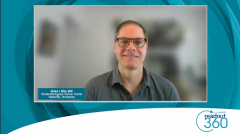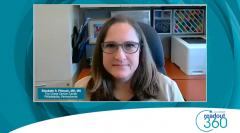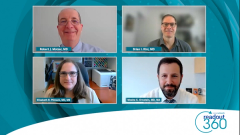
Factors Aiding in the Selection of Frontline Therapy in Advanced Clear Cell RCC
Panelists shed light on key factors that help to inform the selection of frontline therapy in patients with advanced clear cell renal cell carcinoma.
Episodes in this series

Transcript:
Brian I. Rini, MD, FASCO: Thank you...I wanted to ask about [this]. You touched on this Bob, so I’ll ask the others to comment, maybe Betsy, starting with you. Do any of you give a specific regimen based on organ site of disease? Let’s take brain metastases out of that, or you can leave it in. But...those patients get SBRT [stereotactic body radiotherapy] to their lesions, and then they get whatever you would choose otherwise, at least in my practice. But Betsy…do you think cabo [cabozantinib] works better in bone? Do you give cabo/nivo [nivolumab] to bone metastases, or do you not organ direct like that?
Elizabeth R. Plimack, MD, MS: I just don’t organ direct. I’m glad we studied it. I’m glad people are looking at it. I haven’t seen data that compel me to shift my practice based on site of metastasis.
Brian I. Rini, MD, FASCO: Fair enough. Moshe?
Moshe C. Ornstein, MD, MA: Same. I don’t decide on therapies based on sites of metastases. It’s the big picture.
Brian I. Rini, MD, FASCO: And how about toxicity? So, Bob touched on toxicity. A lot of people said they give len/pembro [lenvatinib/pembrolizumab] because of high response rates, which...is fair along [with] PFS [progression-free survival], etc. But clearly...in my opinion, the highest amount of toxicity with len…goes to 20. Betsy, you and I talked about len dosing before. I know you do something...a little bit off label and different, which is fine, I just had to say off label. So…how do you dose len? Are there patients who walk in where you think, I don’t think this patient can tolerate any dose of len—I might choose something else?
Elizabeth R. Plimack, MD, MS: I’ll just say, label doesn’t specify dose. So...I’m still giving it on label, but not…at the approved dose. I start low with len and titrate up. That’s been my approach. [It’s] just easier to get 4-mg tablets with a 12-mg prescription to start and we quickly can go up from there. Again, we are treating for efficacy and the CLEAR [NCT02811861]data we just spoke to have very high efficacy, and then we manage for toxicities so that people can maintain that benefit long term.
Brian I. Rini, MD, FASCO: Moshe, any comments about lenvatinib dosing?
Moshe C. Ornstein, MD, MA: I actually take the opposite approach, saying that we’re treating for efficacy. And in the trial, the dose that was used was 20 mg of lenvatinib. We know that there is some degree of linear pharmacokinetics where a higher dose for the population at large is better. Again, for an individual patient, they might be at 10 mg or 8 mg and doing fine. So, for me, I start at a 20-mg dose, but I really prep patients and I prep my team and I prep their family. I tell them that...in the trial it was 69% or so who required a dose reduction. I say we’re going to start at this dose. Give us the first couple of months where we’re going to figure out the right dose, the right schedule, etc. But I start at the 20-mg dose and…there is the dose exchange program if we’re trying to get...the 4-mg tablets. But I start at 20 mg and then titrate down based on [adverse] effects.
Brian I. Rini, MD, FASCO: And Bob, you led this trial. Any final comments about lenvatinib dosing in your practice?
Robert J. Motzer, MD: No, for the most part I try to dose at the 20 mg because...the efficacy is based on that. There are some patients [who] I do start at a lower dose and they’re primarily ones with marginal management of their high blood pressure. If they have high blood pressure and I’m concerned that it’s not well controlled, then I would treat with a lower dose because the blood pressure toxicity usually occurs very quickly, within days. And so...in that particular population, I consider with a lower dose.
Brian I. Rini, MD, FASCO: I tend to do what Moshe does. I tend to start high and low quickly. But I agree that toxicity can be…significant, especially. You have to be ready for it. You and your team [have] to be really ready to manage it, or else you’re going to not only cause patients harm, but some of them come back and they don’t want to take any dose once they’ve been…burned by 20 mg. So...to me, what’s always remarkable is...20 years and we’re still figuring out how to give TKIs [tyrosine kinase inhibitors] and how to dose them. Some say we’re never going to figure it out and there [are] different ways to do it. Maybe before we move on, I presented a little bit of the data of the CD70 CAR T [chimeric antigen receptor T-cell] product. Any thoughts about that? I know [they’re] early data on…safety and a little bit of efficacy. If you had to predict now, and say yeah...this is going to be a major breakthrough in kidney cancer or not. Who wants to take that one?
Elizabeth R. Plimack, MD, MS: I can take that. I just…wish the limited efficacy we saw were a little bit better. The promise of CAR T coming out of the heme [hematologic] malignancies is just amazing responses that are durable, in effect cures for some patients. Just in terms of the waterfall plot, I just…saw that was like “hmm,” but it’s the first step we probably should iterate. I don’t think it’s a path that’s not worth pursuing. We should pursue it. I just don’t think this study is there yet.
Brian I. Rini, MD, FASCO: Yeah, there’s no clear early signal, but...we’d all agree worth pursuing. We’re all for novel mechanisms.
Transcript is AI-generated and edited for clarity and readability.
Newsletter
Stay up to date on recent advances in the multidisciplinary approach to cancer.
























































































